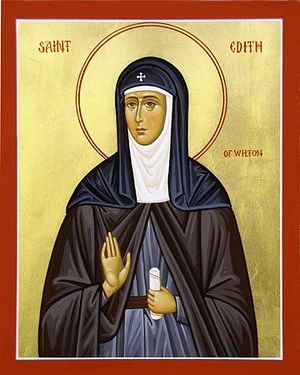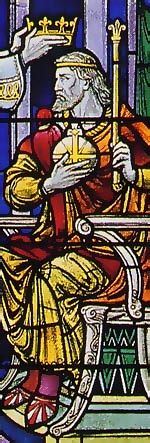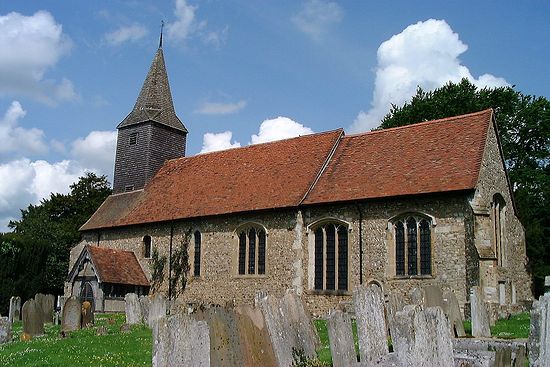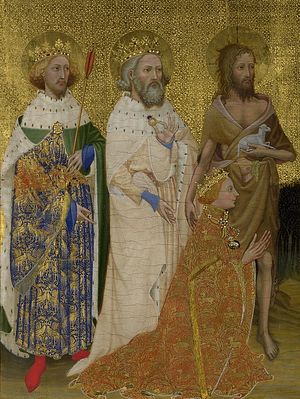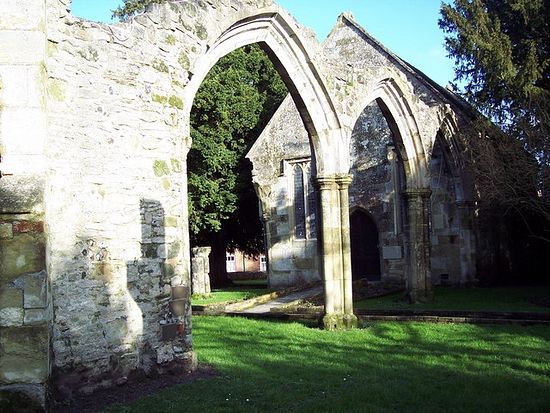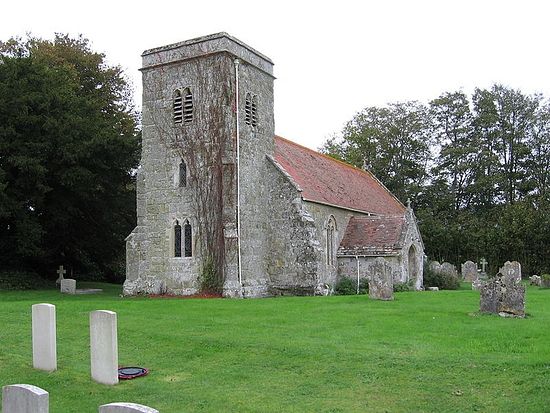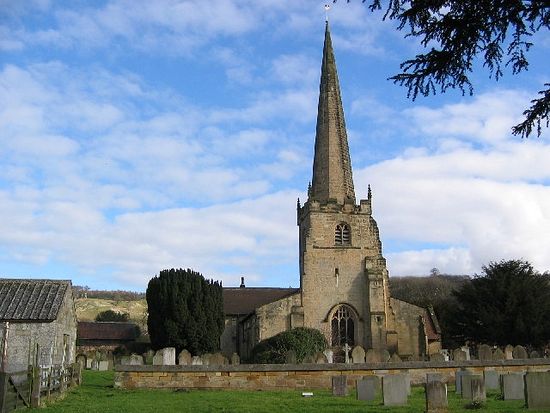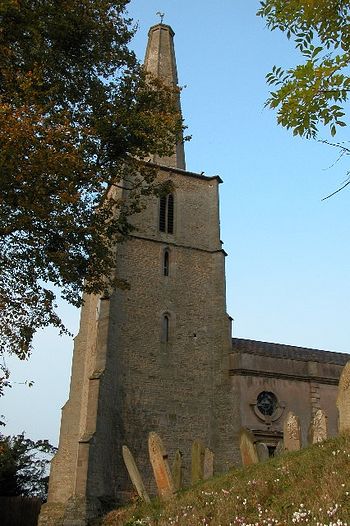St. Edith (also Editha, Eadgyth, Eadgith) was one of the most venerated female saints of England. The Orthodox along with some Roman Catholics and Anglicans honor her memory to this day. The saint’s Life was written by the learned monk Goscelin in the late eleventh century. Let us recall the main details.
The future saint was born in 961 in Kemsing, which is now a village near the town of Sevenoaks in Kent in southeastern England. Her parents were the right-believing King Edgar the Peaceful (943-975) and St. Wilfrida (Wulfthryth). According to one version, a young and still unrepentant Edgar, who had a royal residence in Wilton in Wiltshire in southwestern England, in his native kingdom of Wessex, fell in love with a young noble lady named Wilfrida. She had gone to be instructed at the convent in Wilton near his manor. (Many daughters of noble families used to receive their education at Wilton at that time and many of them later became nuns). He finally abducted Wilfrida and took her to his royal manor at Kemsing in Kent, where a year later she gave birth to Edith. In all probability Wilfrida was his concubine for a while, but soon after Edith’s birth she returned to the convent and became a nun, taking the infant daughter with her. According to another version, Wilfrida was the legal wife of King Edgar for a short time but after the birth of St. Edith they separated, Wilfrida becoming a nun and the king remarrying.
What is known for certain is that St. Edith spent all her short life at the convent and her sainthood was revealed even from childhood. Wilfrida raised her at the convent in piety and away from any temptations of this world. King Edgar supported and endowed the convent for many years until his death. St. Edith took monastic vows at the age of fifteen at Wilton. According to her Life, Edith always observed strict fasting and abstinence, combining a life of prayer with a life of activity. She fed the hungry and strangers, clothed the naked, and took care of the sick. From a very young age she was known for her wisdom, her physical and spiritual beauty, and her angelic voice, and was loved by many for her generosity and close association with animals. It was related that many presented her with domestic and wild animals as gifts and the saint kept them separately within the convent. She used to feed deer and doves from her hand.
St. Edith insisted that a hospital be opened at the convent where the poor and destitute would receive treatment and care. The holy nun preferred the company of lepers and outcasts to that of princes and nobles, meanwhile giving bread, alms and shelter to all who asked for it at any time. The saint even had a habit of washing her fellow sisters’ stockings at nights, thus serving her neighbors all day long. The holy virgin Edith also obtained a very good education at the nunnery; she was very skillful and had many talents (thus, she embroidered an alb, or sticharion, with gold and pearls). She had a large library and most probably excelled in illuminating manuscripts. St. Edith was offered the throne more than once, especially after the martyrdom of her half-brother, St. Edward the Passion-Bearer, but the maiden of God declined each time, choosing to dedicate her life to God entirely instead of having worldly power. Likewise, the saint was offered the abbacy of three different convents at different times, but she humbly refused, preferring to lead the life of a simple nun until her death.
The saint’s biographer noted that St. Edith used to dress magnificently, wearing beautiful and luxurious garments. And in connection with this she would say that the Lord above all looks at our hearts, which must be filled with purity, love and humility. The biographers testified that, like ascetics of the old, she wore a hairshirt underneath her colorful and expensive dress. With time she earned everyone’s affection and reverence for her holy life, compassion, works of mercy, prudence and learning, and the nuns called her “good”. In 979 the saint had a dream in which she lost her right eye, and in the morning she learned that her half-brother St. Edward had been treacherously martyred by conspirators led by his own stepmother at Corfe Castle in Dorset.
St. Edith peacefully reposed in the Lord from fever at the age of twenty-three, on September 15 984. Three weeks before her demise she founded a church of St. Denis, during the consecration of which St. Dunstan, then Archbishop of Canterbury, suddenly began to weep, because the imminent death of such a holy virgin of God had been revealed to him. And it was St. Dunstan who gave her communion before her repose. Interestingly, the saintly virgin had designed the frescoes of St. Denis’ church on her own, and her biographer wrote that they were of a very high quality.
After her death St. Edith appeared to many people in visions. First she appeared in glory to her mother Wilfrida and told her that the evil one had tried to accuse her during her ascent to the heavens but she struck his head and quickly reached Paradise. Then she came in visions to some Wilton nuns. Various miracles started to occur at her grave through her intercessions. As for her mother Wilfrida, she had become abbess of Wilton by that time. Noted for her wisdom and deep repentance, she successfully ruled the community until her death in 988, and afterwards was locally venerated as a saint (feast: September 13/26). The incorrupt relics of St. Edith were subsequently opened and translated to the church of St. Denis which she had founded. Kings Ethelred the Unready, Edmund the Ironside, Canute (Knut) the Great and Edward the Confessor particularly venerated St. Edith themselves and promoted her veneration.
There are two stories connected with King Canute. At first he did not believe that she was a saint and decided to go to Wilton and arrange to open her shrine. But when he did so, still much doubting, the saintly virgin suddenly sat up inside her shrine and slapped the king in the face for his disbelief, after which he came to his senses at once. In about 1020 the same king got into a storm on the way from England to Denmark; he zealously started praying to St. Edith, imploring her to rescue him—and the sea calmed down in the same minute. On returning to England he generously endowed the convent and provided a golden shrine for the relics.
The Abbey of the Mother of God and St. Edith at Wilton remained a celebrated monastic center and destination of pilgrimages for many centuries. It was one of the best known communities of nuns in England, where many representatives of the nobility were educated and led the ascetic life. In the eleventh, century the wife of King Edward the Confessor, also called Edith, rebuilt Wilton Abbey in stone. The historian William of Malmesbury in the early twelfth century attested that the festival of St. Edith (September 16 according to the old calendar) was celebrated at Wilton with great reverence in his age. Among the miracles wrought by Edith after her death let us mention the healing of from eye complaint of Abbess Elgiva of Wilton in about 1066, and her miraculous protection of the nunnery and its possessions from intruders.
However, Sts. Edith and Wilfrida were not the only saints whose relics were venerated at the convent. Let us mention two other ones. Firstly, there was St. Alburgh (or Alburga; feast: December 25/January 7), a sister of King Egbert of Wessex and wife of Wulfstan, ealdorman of Wiltshire. Widowed in 802, she became a nun and founded a convent at Wilton, initially with twelve nuns. She may have become its first abbess. St. Alburgh reposed on the day of Nativity of Christ, December 25, 810. And, secondly, there is St. Ywi (Iwi; feast: October 8/21). He was a disciple of St. Cuthbert on Lindisfarne where he served as a hierodeacon. Later Ywi sailed to Brittany where he spent the rest of his life as a wandering preacher and hermit, performing many miracles and reposing in c. 690. In the tenth century Breton priests took his relics on a tour of England (probably to collect donations for their monastery) and when the relics were visiting Wilton Abbey and were laid on the altar, they suddenly became immovable. All decided that it was the will of God, and so the hermit’s relics remained there forever. Thus St. Ywi became the second most important saint of Wilton after Edith.
Wilton Convent is associated with a rare and unique surviving relic of medieval England—the late fourteenth-century “Wilton Diptych,” which is currently kept in London’s National Gallery. This portable diptych in the Gothic style has two panels, and it shows Richard II (ruled 1377-1399) being presented to Christ and the Mother of God by St. John the Baptist (his patron-saint), St. Edmund the Martyr and Edward the Confessor. The diptych was obviously painted especially for Richard II.
Monastic life at Wilton prospered until the Reformation, when it stopped forever in 1539. Today nothing remains of the large abbey’s structures, though some believe that St. Edith’s relics may lie buried somewhere under the local gardens. The exact site of the original convent is under Wilton House—a stately home to the southeast of Wilton. Now only the ruins of a church connected with the abbey survive in Wilton, a pretty but small historic town in Wiltshire that was earlier the administrative center of this county (now the main city of Wiltshire is neighboring Salisbury). In the fifteenth century, the convent built a parish church in honor of St. Mary the Mother of God in the town for a local parish. This church became redundant long ago as in the nineteenth century a new town parish church was built. Now this nice ancient church lies mostly in ruins—only the nave survives practically intact. It can be easily found in the town center. Wilton also has a Roman Catholic Church of St. Edith.
Veneration for St. Edith in England was nationwide, and she was held as one of the most beloved venerable virgins of the English people. The writer Goscelin, who spent several years at Wilton as a teacher, recalled that he felt a special presence of the saint in the abbey one hundred years after her repose. It was the Wilton nuns who shared with him many details of her life and acquainted him with some of her personal belongings, including her notes and written prayer petitions. Remarkably, the seal of St. Edith still survives. This very rare relic dates back to about 975. There she is depicted standing with one hand raised and other hand holding a book. She is called “royal sister” in the seal’s Latin inscription.
St. Edith is usually depicted as a nun of the royal blood giving alms to a pauper; with a purse; or washing the feet of a stranger. No fewer than twenty-one ancient churches were dedicated to St. Edith of Wilton and at least two of them survive to this day. They are situated in the village of Baverstock near Wilton and in the village of Bishop Wilton in the East Riding of Yorkshire, far in the north. There is also the village of Limpley Stoke in Wiltshire near the Somerset border where the tenth-century church was originally dedicated to St. Edith but since the sixteenth century its patron has been the Mother of God. Besides, there are no fewer than five churches across England dedicated to “St. Edith” without further indication and it is next to impossible to identify whether their patron saint is Edith of Wilton or Edith of Polesworth, who lived a generation earlier than our saint.
St. Edith is still much venerated at her birthplace, in the picturesque large village of Kemsing in Kent. The ancient holy well in the center of the village bears the name of St. Edith. Its water has been known for its healing properties, especially for eye diseases, and local farmers also used its water to bless fields and for rich harvests. Recently the ancient tradition of annual “well-dressing” has been revived there. Local communities organize annual processions to the well. The village’s parish church is dedicated to the Mother of God; it has two beautiful stained glass windows depicting St. Edith and a banner dedicated to her. The front of the Kemsing village hall (a local club) is beautifully adorned with a clock and a statue of St. Edith, who is honored by the villagers. There is another ancient holy well dedicated to our saint—in the Herefordshire village of Stoke Edith in the very west of England. This well was once famous for its curative properties, and pilgrims flocked to it for bathing and healing as late as the mid-nineteenth century. Now it is on private property and not accessible to pilgrims. The local village church is again dedicated to the Mother of God. Thus the memory of the royal princess and virgin Edith of Wilton, who rejected taking up both secular and spiritual power and chose to live in humility and holiness, is preserved in the English land.
Holy Mother Edith of Wilton, pray to God for us!

